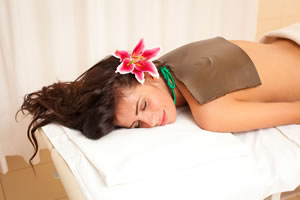Thermotherapy

Thermotherapy uses hot or cold applications to relieve pain by either decreasing swelling or increasing blood flow. There are several different thermotherapy methods and products. Some of them include heating pads, whirlpool baths, and even your typical household icepack. Following is a brief explanation about each form and how you can achieve these methods of therapy.
- Cold applications (such as ice packs) are used to reduce swelling and lower the pain in a specific area. They are most often used for sprains, bruises, stress fractures, and other types of injuries where swelling needs to be reduced. If you have poor blood circulation, it may not be advisable to apply cold to the area. If you use ice therapy, make sure that you do not place the cold product directly on your skin. You will want to place some type of cloth between the ice pack and your skin, otherwise, it may cause discomfort and further damage the area.
- Hot applications, such as a hot water bottle, heat compress, or heating pad, are used to boost blood flow to the area, which helps inflammation run its course, and ultimately reduces the amount of pain you experience. Heat opens up blood vessels and supplies oxygen and other nutrients to the area. Applying superficial heat to your body can improve the flexibility of tendons and ligaments, increase range of motion, reduce muscle spasms, and alleviate pain. You shouldn’t apply heat to an area for longer than 20 minutes (never fall asleep on a heating pad). You should not use heat when the affected area is swollen (that is for cold application).
- You may also be interested in Contrast Bath Therapy (also known as hot/cold immersion). To achieve this form of thermotherapy, you place the injured body part into a bucket or bath of ice water, then immediately follow with an immersion into warm water. This alternation of hot and cold has been practiced for centuries to decrease pain and increase the circulation of blood to the injured area. Contrast baths flush away toxins and other waste product that is inside the tissue and bring other nutrients and oxygen to the injured area, which is a huge benefit for the healing process.
- The most common way to accomplish the contrast bath method is to fill two tubs or large buckets (a double sink in the kitchen can also work well): one tub with hot water and one with cold. The idea is to soak the affected area in the hot water for around 3 minutes, then switch to the cold water, soaking for only one minute. You should always start with the hot water and end with the cold water. It is advisable to be careful when adjusting the temperature and to make sure it is a comfortable temperature for you. Some patients might think they can achieve faster results by using extreme temperature changes, however, this is not only dangerous but may produce undesired effects.
- The most common way to accomplish the contrast bath method is to fill two tubs or large buckets (a double sink in the kitchen can also work well): one tub with hot water and one with cold. The idea is to soak the affected area in the hot water for around 3 minutes, then switch to the cold water, soaking for only one minute. You should always start with the hot water and end with the cold water. It is advisable to be careful when adjusting the temperature and to make sure it is a comfortable temperature for you. Some patients might think they can achieve faster results by using extreme temperature changes, however, this is not only dangerous but may produce undesired effects.

